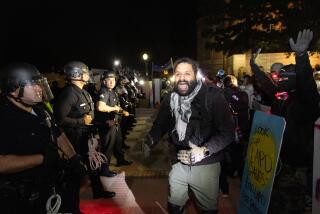UCI Professor Caught Up in Tibetan Clash
- Share via
One of the first things Karen Leonard saw as she was swept into the main square in Tibet’s capital earlier this month was the lifeless body of a demonstrator being borne aloft by an angry, stone-throwing crowd.
“We all surged back and forth, three feet from the soldiers, going up against the wall,” the UC Irvine professor wrote in her diary, describing the tumultuous events in Barkhor Square in the city of Lhasa. “Shots being fired--from police station area, towards us--we ducked behind Stupas (religious monuments)--surged forward with crowd again. . . . I took a photo.”
Like most historians, Leonard is used to recreating pivotal political events from dry documents and other people’s first-hand accounts.
But on Oct. 1, standing atop the Jokhong Temple, the 47-year-old professor watched as a clash of historic significance erupted below between Buddhist demonstrators and Chinese authorities.
What Caused Violence?
More than three weeks later, there still is uncertainty about what caused the demonstration of fewer than 100 shaven-headed monks and pilgrims to explode into a confrontation with armed Chinese police and militiamen that left an estimated 14 people dead, a dozen vehicles destroyed and a police substation in smoldering ruins.
Among the apparent factors were a Sept. 21 speech by Tibet’s exiled spiritual leader, the Dalai Lama, to the U.S. Congress’ Human Rights Caucus in Washington, and a Sept. 24 rally in Lhasa, where at least one Tibetan was executed by Chinese authorities.
Leonard, a widow with grown children, was in Lhasa primarily as a tourist; her field is the history and anthropology of India. But she recalled in a recent interview on the UCI campus, where she has taught for the past 15 years, that when the violence erupted, “I knew enough about Tibet to know this was tremendously important.”
For Leonard, shooting pictures and making terse diary notations from above the square in Tibetan Buddhism’s holiest shrine were only the beginning of her exposure to history in the making.
From what she called “a perfect vantage point, above it all,” Leonard said, “you could see the confrontation was going to take place (below on the square).” Before long, things “took a very immediate, violent turn (in the temple).”
On the roof of the Jokhong, younger monks began throwing stones onto the square, and a Chinese TV crew near her was assaulted. When other Chinese visitors were attacked throughout the complex, older monks decided to close the temple to end the violence.
“The monks pushed us out the front door into the square,” where, she said, “the mobs were moving back and forth,” shouting independence slogans and waving Tibet’s outlawed flag.
One of the first things she heard was “the tap-tap of stones being broken as (the demonstrators) made more ammunition (to throw at the Chinese).”
Tibet has moved in and out of the Chinese sphere of influence for more than 1,000 years, and Chinese control of the mountainous nation of 2 million is one of the few points of agreement between the Communist government in Beijing and the Nationalists on Taiwan.
Following the collapse of the Qing dynasty in 1911, Imperial Chinese occupation forces were driven out by the Tibetans. Communist troops returned in 1950, and a rebellion led by the Dalai Lama in 1959 was crushed, causing the Buddhist leader to flee into exile. Many temples and monasteries were leveled by Red Guard rampages during the 1966-1976 Cultural Revolution.
Leonard’s sympathy for the Tibetans’ cause notwithstanding, she is objective in describing the origin of the clash and the violence unleashed on Chinese civilians.
From her viewpoint, it appeared initially that the Tibetan demonstrators and the police seemed to run toward each other and that the monks seemed to be “courting arrest. . . . The Chinese had guns, but they didn’t use them (at first),” she said. “It was pretty clear they weren’t going to fire.”
Chinese civilians on the square also were brutally beaten by demonstrators without visible provocation.
“We could see individual Chinese picked out and persecuted,” she said.
Amid the chaos in the square, Leonard managed to record in her diary some comic relief, in the form of Western expatriates, superannuated hippies by their long hair and dress: “Much casualness among these hardened fellows--five of them sat smoking dope in the middle of the fray.”
Ultimately it was hunger, rather than fear or good sense, that caused Leonard and her friend to leave the square. They returned to the Lhasa Hotel for lunch, where, she said, “we felt we were coming from the battle front.”
After lunch, curiosity drew them back briefly to Barkhor Square to observe what had happened, but the size of the crowd--now in the thousands--and the intensity of the their actions and the Chinese reaction caused them to beat a hasty retreat. The next morning, Leonard left for a five-day trip from Lhasa to Katmandu, the capital of Nepal, where she was interviewed by news-hungry reporters and completed a month-long trip that included India and Indonesia, as well as Nepal and Tibet.
In retrospect, Leonard acknowledges the danger of the experience in Lhasa.
“I don’t know what we thought we were doing,” she says. “It was interesting.”
More to Read
Sign up for Essential California
The most important California stories and recommendations in your inbox every morning.
You may occasionally receive promotional content from the Los Angeles Times.













